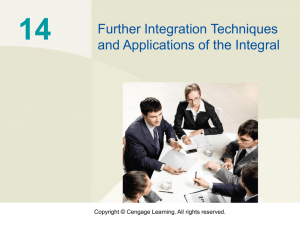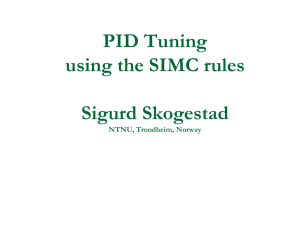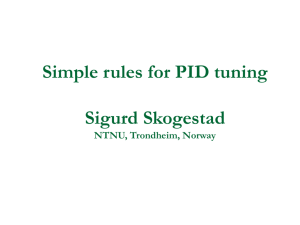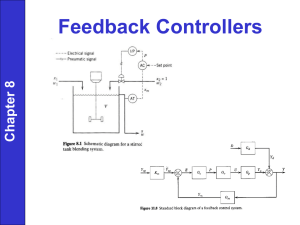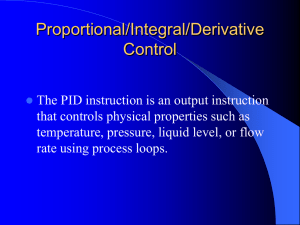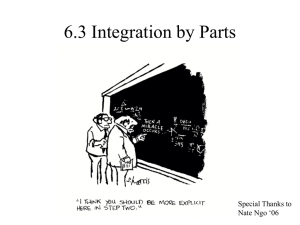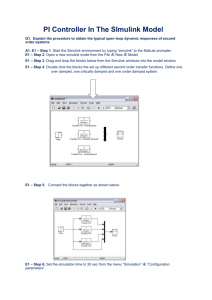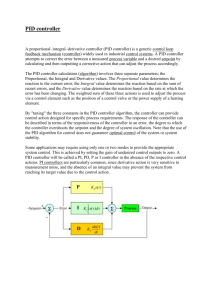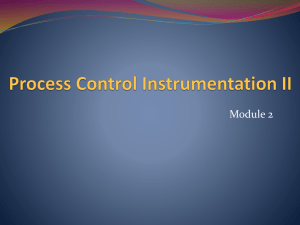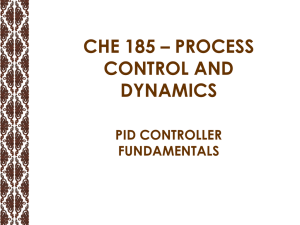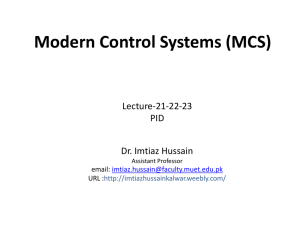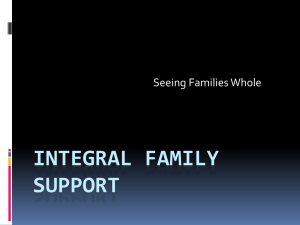powerpoint
advertisement
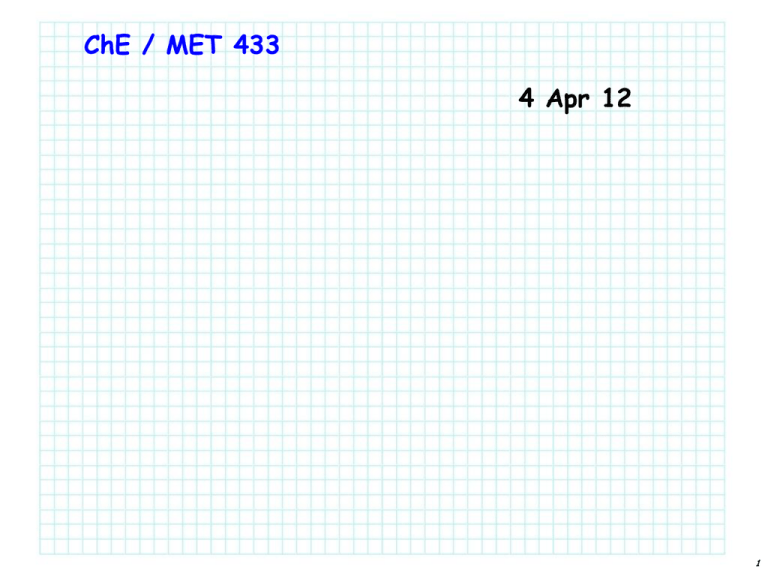
ChE / MET 433 4 Apr 12 1 Feedback Controller Tuning: (General Approaches) 1) Simple criteria; i.e QAD via ZN I, tr, etc • easy, simple, do on existing process • multiple solutions 2) Time integral performance criteria • ISE integral square error • IAE integral absolute value error • ITAE integral time weighted average error 3) Semi-empirical rules • FOPDT (ZN II) • Cohen-Coon 4) ATV, or Autotuning 5) Trial and error 6) Rules of thumb 2 Trial and Error (field tuning)* • Select the tuning criterion for the control loop. • Apply filtering to the sensor reading • Determine if the control system is fast or slow responding. – For fast responding, field tune (trail-and-error) – For slow responding, apply ATV-based tuning • Turn off integral and derivative action. • Make initial estimate of Kc based on process knowledge. • Using setpoint changes, increase Kc until tuning criterion is met ys c a b Time * J.B. Riggs, & M.N. Karim Chemical and Bio-Process Control, 3rd ed. (2006) 3 Trial and Error (field tuning)* Decrease Kc by 10%. Make initial estimate of tI (i.e., tI=5tp). Reduce tI until offset is eliminated Check that proper amount of Kc and tI are used. c b ys • • • • a Time * J.B. Riggs, & M.N. Karim Chemical and Bio-Process Control, 3rd ed. (2006) 4 Kc and Kc tI levels good? tI 5 Feedback Controller Tuning: (General Approaches) 1) Simple criteria; i.e QAD via ZN I, tr, etc • easy, simple, do on existing process • multiple solutions 2) Time integral performance criteria • ISE integral square error • IAE integral absolute value error • ITAE integral time weighted average error 3) Semi-empirical rules • FOPDT (ZN II) • Cohen-Coon 4) ATV, or Autotuning 5) Trial and error 6) Rules of thumb 6 Rules of Thumb * sec ** • • • • sec Flow Loops: typically PI controllers; PB ~ 150; t I 0.1 min Level Loops: PI for tight control; P for multiple tanks in series; Pressure Loops: can be fast or slow (like P control by controlling condenser) Temperature Loops: typically moderately slow; typically might use PID controller; PB fairly low (depends on gains); integral time on order of process time constant, with faster process t I can be smaller derivative time ~ ¼ the process time constant. * D.A.Coggan, ed., Fundamentals of Industrial Control, 2nd ed., ISA, NC (2005) ** W.L.Luyben, Process Modeling, Simulation and Control for Chemical Engineers, 2nd ed., McGraw-Hill (1990) 7 Higher Order Process 8 Feedback Controller Tuning: (General Approaches) 1) Simple criteria; i.e QAD via ZN I, tr, etc • easy, simple, do on existing process • multiple solutions 2) Time integral performance criteria • ISE integral square error • IAE integral absolute value error • ITAE integral time weighted average error 3) Semi-empirical rules • FOPDT (ZN II) • Cohen-Coon 4) ATV, or Autotuning 5) Trial and error 6) Rules of thumb 9 Feedback Control •Design Disturbances: •Load •Setpoint Questions: •Type of controller to use? •How select best adjustable parameters? •Performance criteria? Guidelines: •Define performance. •Obtain “best” parameters, for K C ,t I ,t D •Select controller with “best” performance. 10 Feed Back Control •PID controllers Proportional: •Accelerates response •Offset Controller with “best” performance. •P – only if can •PI – eliminate offset •PID – speed up response of sluggish systems (T, comp, control; multi-capacity systems) Integral: •Eliminates offset •Sluggish responses •If increase Kc, more oscillations -> unstable? Derivative: •“Anticipates” future error •Stabilizing effect •Noise problem 11 Examples: 12 13 14 15 16 E s Controllers: P-Only: mt m K c r (t ) c(t ) M s K c E (s) P-I Controller: P-I-D Controller: tD mt m K c e(t ) Kc tI Gc M s e(t ) dt M s 1 K c 1 E (s) t I s 1 d e(t ) mt m K c e(t ) e(t ) dt t D t dt I Derivative (rate) time [=] time Chapter 5 ~ p 183 M s 1 K c 1 t D s E (s) t I s 17 Derivative Action: P-I-D Controller: R(t ) 1 d e(t ) mt m K c e(t ) e(t ) dt t D t dt I A C (t ) e(t ) C (t ) R(t ) A e(t ) t slope d e(t ) dt C (t ) slope d C (t ) dt t 1 d C (t ) mt m K c e(t ) e(t ) dt t D t dt I 18 Derivative Action: Another potential problem: noise R(t ) A filter C (t ) e(t ) C (t ) e(t ) t slope t Ds t D s 1 small 0.05 0.2 19 PID Derivative action: Advantages: • Reduces overshoot • Reduces oscillations • Recommended for slow/sluggish processes (speed up control) Disadvantages: • Susceptible to noise • Filtering (or averaging PV) introduces delay • 3rd tuning parameter 20 PID Control PID Tuning • Tune for PI • Derivative: •Add in tD •Minimum response time •tD initial = Tu/8 •Adjust Kc and tI by same factor (%) •Check response has correct level of integral action PS: Try PID for HE process on Loop Pro Developer 21 Rules of Thumb * ** • • • • Flow Loops: typically PI controllers; PB ~ 150; t I 0.1 min Level Loops: PI for tight control; P for multiple tanks in series; Pressure Loops: can be fast or slow (like P control by controlling condenser) Temperature Loops: typically moderately slow; typically might use PID controller; PB fairly low (depends on gains); integral time on order of process time constant, with faster process t I can be smaller derivative time ~ ¼ the process time constant. * D.A.Coggan, ed., Fundamentals of Industrial Control, 2nd ed., ISA, NC (2005) ** W.L.Luyben, Process Modeling, Simulation and Control for Chemical Engineers, 2nd ed., McGraw-Hill (1990) 22 ChE / MET 433 23
